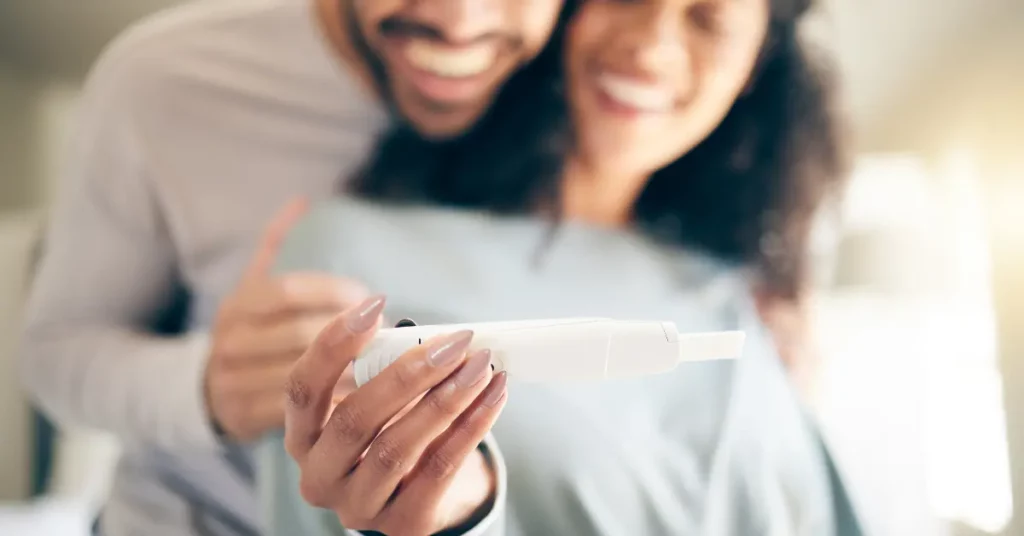Intrauterine insemination (IUI) is a fertility procedure where a doctor places washed sperm directly into the uterus around ovulation. While it’s a relatively simple treatment, the success of an IUI treatment can rest on precise IUI timing. Timing the insemination to coincide with the egg’s release is critical for achieving pregnancy. This article explains how to identify the optimal window for IUI, how tracking your cycle improves timing, and why working closely with your clinic is crucial. By understanding these elements, you can better plan your IUI and maximize your chances of conception.
Understanding the IUI Ovulation Window
Like natural conception, IUI success depends on sperm meeting the egg during a short fertile window. The IUI ovulation window refers to the period around ovulation when an egg is available for fertilization. An egg survives only about 12–24 hours after ovulation, so the goal is to have plenty of sperm waiting in the reproductive tract at that moment. In other words, the insemination must occur very close to when the ovary releases an egg. According to fertility specialists, the timing of IUI is critical because sperm must reach the egg within roughly 12–24 hours post-ovulation for fertilization to occur. If IUI is done too early, the egg isn’t released yet; if done too late, the egg may no longer be viable.
A woman’s fertile window generally spans the few days leading up to ovulation and the day of ovulation itself. Sperm can survive for up to 3–5 days in fertile cervical mucus, but a freshly ovulated egg quickly begins deteriorating within a day if not fertilized. With IUI, sperm are placed directly into the uterus, bypassing the cervical mucus reservoir. This may shorten their effective lifespan compared to intercourse, making timing even more crucial. The IUI window post-ovulation is narrow – ideally, the IUI occurs just before or at ovulation so that sperm encounter the egg immediately. Doctors often aim to perform IUI on the day of ovulation or the day before.

Tracking Ovulation and Monitoring Fertile Window
Most clinics will guide you through an IUI cycle tracking using a combination of at-home tests and in-office monitoring. One common approach is using ovulation predictor kits (OPKs) to detect the luteinizing hormone surge. The LH surge precedes ovulation by about 24–36 hours, signalling that an egg will soon be released. When to do IUI after LH surge is a frequent question – generally, a single IUI is scheduled about 24 hours after you first detect your LH surge. This timing often means insemination will occur within roughly a day of ovulation, which is ideal. In practice, many clinics instruct patients to call as soon as they get a positive OPK. The clinic then arranges to get IUI appointments for insemination the next day or so.
In addition to home test kits, your doctor may use transvaginal ultrasounds and blood hormone tests to pinpoint ovulation. Ultrasounds can track the growth of ovarian follicles (which contain the developing eggs) and identify when a follicle is about to rupture (ovulate). Blood tests for estrogen and LH levels also help indicate when ovulation is imminent. Using these tools, your physician can narrow down the ovulation time very precisely. As the Mayo Clinic notes, because the timing of IUI is key, checking for ovulation signs is crucial, whether through an at-home LH kit or ultrasound monitoring. In some cases, fertility medications are used to control ovulation timing. You might be given a trigger shot of human chorionic gonadotropin (hCG) to induce ovulation on a known schedule. When medication is used to trigger ovulation, the IUI is typically planned about 36 hours after the injection. This ensures the procedure is timed just when the egg is released.
Keep in close communication with your IUI clinic during this monitoring phase. They will likely provide clear instructions on when to start testing and when to call to schedule an IUI appointment. By diligently tracking ovulation through daily OPK tests, ultrasound appointments, or both, you greatly reduce the risk of missing your fertile window. Missing the window could mean cancelling the IUI for that cycle, so careful tracking is essential. If you’re ever unsure whether you’ve gotten a positive LH test or ovulation sign, err on the side of contacting your clinic. It’s better to undergo a monitoring scan or blood test than to miss the timing. With thorough tracking, you and your doctor can coordinate the IUI for the exact right moment.
Cycle Day Considerations and IUI Scheduling
Understanding how cycle day affects IUI can also help you plan more effectively. Ovulation (and thus the IUI timing) doesn’t occur on the same cycle day for everyone – it depends on the length and regularity of your menstrual cycle and whether fertility drugs are used. In a natural cycle of around 28 days, ovulation often occurs around cycle day 14 (with day 1 being the first day of your period). In this common scenario, many doctors would perform IUI on about day 14 or 15. However, that is just an average estimate. If your cycle is shorter or longer, ovulation might happen earlier or later. For example, a woman with a 35-day cycle might ovulate closer to day 21, meaning the IUI would be scheduled much later in the cycle. The key is that the procedure date is determined by ovulation timing, not a fixed day of the cycle.
There are some general IUI cycle day recommendations that clinics provide as guidelines. Often, you’ll be asked to call the clinic at the start of your period (cycle day 1) to set up the cycle monitoring schedule. They may bring you in around day 10–12 for an ultrasound to see how your follicles are developing (especially if you’re on ovarian stimulation medications). If you are using a medication like clomiphene (Clomid) or letrozole, you might take it in the early part of the cycle (say days 3–7). Then, around mid-cycle, ultrasound and blood tests will help pinpoint when a follicle is mature (around 18–20 mm in size). At that point, the clinic might administer the hCG trigger shot to force ovulation and plan the IUI for about 36 hours after the trigger. In a medicated cycle, the actual IUI timing could be a bit more predictable because the trigger shot sets the clock for ovulation. In an unmedicated cycle, the timing depends on your body’s signals, which is why daily LH tests and possibly multiple ultrasounds are needed.
Side Effects of IUI
While this procedure is generally considered a safe and low-risk fertility treatment, it’s important to be aware of potential risks and side effects. The most common side effects after an IUI procedure are mild cramping and light spotting, which usually resolve within a day or two. Some individuals may also experience temporary bloating or discomfort related to the use of a speculum during the procedure. Suppose fertility medications are used to stimulate ovulation. In that case, there is a higher chance of releasing multiple eggs, which can increase the likelihood of a multiple pregnancy. Rarely, IUI can lead to infection due to the introduction of instruments into the uterus, but clinics use sterile techniques to minimize this risk. Another uncommon but possible side effect is ovarian hyperstimulation syndrome (OHSS), which can cause the ovaries to become swollen and painful if fertility drugs are overused. Understanding these risks helps you make informed decisions and prepares you for the IUI process.

Understanding IUI Success Rates and Factors
When understanding IUI success, it’s essential to manage expectations and know the factors at play. IUI has a moderate success rate per attempt – commonly cited success rates are on the order of 10% to 20% per cycle. IUI is attempting to mimic and assist natural fertilization, so its per-cycle success odds are in the same ballpark. Many people do achieve pregnancy with IUI, but it often takes multiple tries. Several key factors influence success:
- Age of the woman: Female age is one of the most significant factors. Women under 35 generally have higher IUI success rates, while success decreases for women in their late 30s and 40s as egg quantity and quality diminish.
- Ovulation and ovarian health: Regular ovulation and good ovarian reserve improve success. If ovulation is irregular or eggs are of poorer quality, it can reduce the chances. Medications can help stimulate ovulation in some cases to improve odds.
- Sperm quality and count: The male partner’s sperm count and motility are crucial. Even though sperm is placed closer to the egg in IUI, you still need a sufficient number of healthy, moving sperm to reach and fertilize the egg. Sperm washing concentrates the best sperm for use, but IUI success is lower if the post-wash total motile sperm count is very low.
- Timing of the IUI: Of course, as we have discussed, performing the IUI at the correct time is critical. If the insemination is poorly timed relative to ovulation, success rates drop sharply. Timing is one factor we can control with careful monitoring.
- Uterine and endometrial factors: A receptive uterine lining is important for the embryo to implant after fertilization. Issues like a very thin endometrium, uterine polyps, or fibroids can impair implantation and thus lower IUI success. Your doctor may check the uterine cavity and lining thickness during the cycle.
- Underlying infertility causes: The reason you’re doing IUI in the first place matters. IUI tends to work best for unexplained infertility or mild male-factor issues. If there are severe factors, IUI success will be much lower, and IVF might be recommended instead. Addressing any treatable condition (such as a thyroid imbalance or endometriosis) can improve your IUI prospects.
All these factors interplay to determine the outcome. Many fertility specialists suggest a course of about 3–6 IUI cycles before considering more advanced treatments like IVF, depending on the individual’s age and diagnosis. The good news is that each attempt is independent; even if one cycle fails, the next cycle still has the same statistical chance of success, and the cumulative probability increases with each subsequent cycle.
Post-IUI Expectations and Next Steps
Understanding the typical post-IUI experience can help manage expectations and reduce anxiety during the waiting period. Here are key points to guide you through this important phase:
- Navigating the Two-Week Wait: The period between your IUI procedure and the earliest reliable pregnancy test is often called the “two-week wait.” During this time, it’s normal to feel anxious or impatient for results. Hormonal changes may cause symptoms similar to either early pregnancy or an impending period, making it difficult to interpret physical signs. Focusing on self-care, maintaining your usual routine, and seeking support from friends or support groups can make this waiting period more manageable.
- Recognizing Common Post-IUI Symptoms: After IUI, it’s common to experience mild cramping or light spotting for a day or two. These symptoms are usually harmless and related to the procedure itself. Some individuals may also experience breast tenderness, bloating, or fatigue, which can be caused by hormonal fluctuations or the use of certain medications. It’s important to remember that these sensations do not reliably indicate whether the procedure was successful or not. If you experience severe pain, heavy bleeding, or unusual symptoms, contact your healthcare provider for guidance.
- Determining When and How to Test for Pregnancy: Patience is crucial when deciding the right time to test for pregnancy after IUI. Testing too early can lead to inaccurate results, especially if fertility medications were used, as they may cause false positives. Following your doctor’s advice on the timing and type of test will give you the most reliable outcome and help avoid unnecessary disappointment.
- Managing Activities and Lifestyle: There are typically no strict restrictions on daily activities after an IUI, so most people can return to work, exercise, and normal routines. However, it’s wise to avoid activities that cause discomfort or excessive stress. Eating a balanced diet, staying hydrated, and getting enough rest can support your overall well-being. If you have questions about specific medications, supplements, or activities, your healthcare team is the best resource for personalized advice.
- Considering Next Steps if IUI is Unsuccessful: If you do not become pregnant after your IUI cycle, it’s natural to feel disappointed. Most fertility specialists recommend trying several cycles before moving on to other treatments. Your doctor will review your results and discuss whether to repeat IUI, adjust your treatment plan, or consider alternatives such as IVF.
While the post-IUI period can be emotionally challenging, understanding what to expect empowers you to navigate this time with more confidence.

Financial Considerations: IUI Cost Efficiency
Aside from medical factors, couples must consider the financial aspect of multiple IUI attempts. The IUI cost per cycle is significantly lower than the cost of an IVF cycle, making IUI an attractive first-line treatment. In the United States, IUI typically runs anywhere from a few hundred dollars up to around $2,000 per cycle, depending on the clinic and whether fertility medications are used. By contrast, an IVF cycle can cost $12,000–$20,000 or more. Because IUI is so much less expensive, many patients choose to try IUI several times before moving to IVF. Even if it takes several cycles, the total expense of a few IUIs is often still lower than one IVF attempt.
It’s essential to be strategic, as costs can accumulate if multiple cycles are performed. For example, doing 4–5 IUI cycles with medications might approach or exceed half the cost of an IVF cycle. Proper timing and cycle management become not only a medical priority but a cost-efficiency measure too. You want each attempt to have the best possible chance so that you hopefully need fewer total cycles to succeed. If an IUI is done at a suboptimal time, it’s essentially a lost opportunity. In addition, some patients have insurance coverage that may limit how many IUI attempts are covered. Always check with your insurance what is included; sometimes monitoring or medications are covered even if the insemination itself isn’t, or vice versa.
Consultation and Scheduling Your IUI
Because timing can be tricky to manage on your own, it’s wise to involve a fertility specialist early and make a concrete plan for your IUI cycle. You should schedule fertility consultations with a reproductive endocrinologist before the cycle in which you intend to do IUI. In this consultation, the doctor will review your medical history, perhaps perform some baseline tests, and map out a strategy for your IUI. Essentially, this visit is where you and the doctor determine the best approach for timing in your specific case. For instance, if you have very regular cycles, the plan might be to use OPKs at home and come in once you surge. If your cycles are irregular, the doctor may schedule multiple follow-up visits for monitoring. Don’t hesitate to ask questions during this appointment – understanding the timeline and having a clear calendar of what to do on each cycle day will reduce anxiety and confusion later on.
Good communication with your healthcare team is key. A reputable fertility center will guide you through the process step by step. The team at IVF Center Hawaii works closely with patients to monitor their cycles and schedule IUIs at the optimal time for success. Ultimately, by partnering with an experienced clinic and adhering to their recommended timing, you give yourself the best possible chance of achieving a successful pregnancy. Remember to maintain some flexibility – sometimes an IUI might be moved up or delayed by a day if monitoring shows ovulation is early or late. Trust your doctor’s expertise; their goal is the same as yours: to achieve a successful pregnancy.
Sources
- RMA of New York – Intrauterine Insemination (IUI)rmany.comrmany.com
- Fertility Institute of San Diego – “6 Key Factors That Affect IUI Success”fertilityinstitutesandiego.com
- Mayo Clinic – Intrauterine insemination (IUI) proceduremayoclinic.org
- Society for Assisted Reproductive Technology (SART) – The Difference Between IUI and IVFsart.org